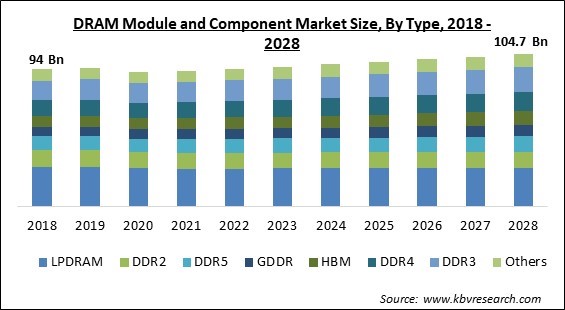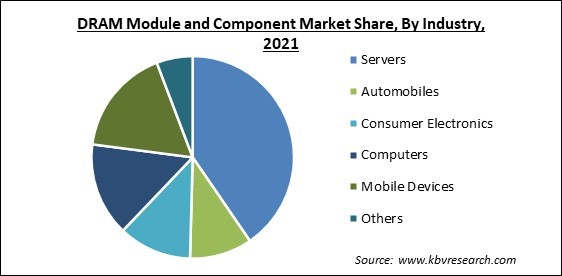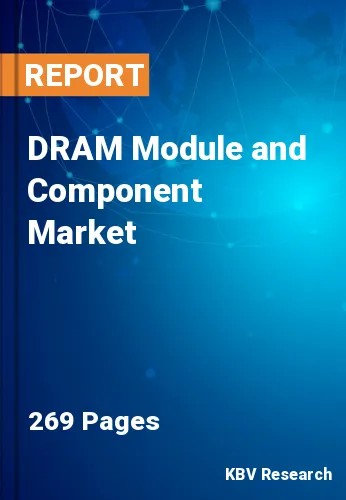The Global DRAM Module and Component Market size is expected to reach $104.7 billion by 2028, rising at a market growth of 1.7% CAGR during the forecast period.
DRAM modules are circuit boards that include a collection of dynamic random-access memory (DRAM) chips. DRAM chips are single-transistor dynamic memory cells that store bits in a row-and-column addressable configuration using capacitors. DRAM chips are a sort of random-access memory (RAM) that needs to be charged or refreshed on a regular basis in order to preserve data.
A DRAM module requires a power supply to maintain its data because it is a dynamic memory device. DRAM modules use volatile memory in this fashion. Static memory, on the other hand, does not necessitate the replacement of the capacitor. Data is retained in flash memory regardless of the power DRAM modules are utilized in servers as well as desktop and laptop computers.
Different types of DRAM modules are used in servers to improve memory capacity, in networking applications to expand bandwidth and preserve signal integrity, and in mobile applications to offer memory capacity while consuming less power and being more compact. Distinct types of DRAM modules can be chosen depending on their properties. Modules such as synchronous DRAM (SDRAM), extended data out (EDO), and fast page mode (FPM) are examples.
The DRAM modules utilized in high-speed, low-power applications are frequently synchronous DRAM modules. DRAM Modules are utilized mostly in mainstream desktop or server applications and come in a number of memory and speed options. DRAM modules have replaced older, obsolete extended data out (EDO) and fast page mode (FPM) modules.

The COVID-19 pandemic has wreaked havoc on the supply chains of mobile devices, computers, and consumer electronics, which are the primary end-user industries for DRAM modules and components. Lockdowns and the halting of production activities have impeded economic growth even more, upending the global semiconductor industry and causing a massive chip shortage that has impacted autos, computers, and other businesses throughout the world. Despite this, the shortage has created an opportunity for investment and the rise of new participants in the semiconductor business; semiconductor manufacturers are now scrambling to increase production.
The introduction of the 5G cellular network has added more lanes to the information superhighway, allowing massive volumes of data to travel quicker and more freely, reducing traffic congestion. 5G, which is enabled by advances in memory and storage, when combined with next-generation technologies like artificial intelligence (AI), has the potential to convert mobile gadgets into foresightful, intuitive, and truly smart companions. The 5G/AI revolution will alter how people communicate, work, consume, recreate, and experience the world.
The Internet of Things (IoT) allows physical and virtual items to communicate and exchange data and information via cloud technologies. IoT is a network of machines and humans, not merely a network of internet-connected devices. The Internet of Things (IoT) refers to the ever-expanding network of physical items as well as the communication that takes place between these objects and other internet-connected devices and systems. The IoT ecosystem is rapidly expanding due to the availability of numerous smart goods for home and industrial uses.
Stability at high temperatures and in harsh environments is one of the most important requirements for new memory technologies. Some memory is stable and performs well in extreme temperatures. As a result, they're used in a variety of applications in which they're subjected to extremely high and low temperatures. However, in such high environmental conditions, certain scalability and stability concerns arise in the operation of most memory. Elevated temperatures have a negative impact on reliability. DRAM thermal issues are compounded by designers cramming more DRAM chips into already overcrowded DIMMs.

Based on type, the DRAM Module and Components Market is divided into DDR2 DRAM, DDR3 DRAM, DDR4 DRAM, DDR5 DRAM, LPDRAM, GDDR, HBM, and Others. The LPDRAM segment acquired the largest revenue share in the DRAM module and component market in 2021. Low-Power Double Data Rate (LPDR), often known as LPDR SDRAM, is a low-power synchronous dynamic random-access memory (SDRAM) designed for mobile computers and devices such as phones.
Based on memory, the DRAM Module and Components Market is bifurcated into, Up to 1GB, 2GB, 3-4GB, 6-8GB, and above 8GB. The 6-8 GB segment obtained a substantial revenue share in the DRAM module and components market in 2021. Having at least 6GB of RAM allows users to load up a reasonable number of browser tabs and leave enough RAM for using email, working with applications like Microsoft Word, and playing casual games. That makes 6-8 GB a good minimum specification for most casual users.
Based on End-user industries, DRAM Module and Components Market is segmented into Consumer Electronics, Mobile Devices, Servers, Computers, Automobiles, and Others. The servers segment acquired the largest revenue share in the DRAM module and components market in 2021. DRAM is a form of random access memory (RAM) that is commonly found in PCs, workstations, and servers. Random-access memory allows the PC processor to access any area of the memory without having to go through the memory in order. DRAM (Dynamic Random Access Memory) is a crucial component of data processing. The massive volumes of data being generated are driving unprecedented DRAM demand in cloud, data center, on-premises, and at the edge.
| Report Attribute | Details |
|---|---|
| Market size value in 2021 | USD 93.1 Billion |
| Market size forecast in 2028 | USD 104.7 Billion |
| Base Year | 2021 |
| Historical Period | 2018 to 2020 |
| Forecast Period | 2022 to 2028 |
| Revenue Growth Rate | CAGR of 1.7% from 2022 to 2028 |
| Number of Pages | 269 |
| Number of Tables | 450 |
| Report coverage | Market Trends, Revenue Estimation and Forecast, Segmentation Analysis, Regional and Country Breakdown, Companies Strategic Developments, Company Profiling |
| Segments covered | Type, Memory, Industry, Region |
| Country scope | US, Canada, Mexico, Germany, UK, France, Russia, Spain, Italy, China, Japan, India, South Korea, Singapore, Malaysia, Brazil, Argentina, UAE, Saudi Arabia, South Africa, Nigeria |
| Growth Drivers |
|
| Restraints |
|
Region-wise, the DRAM Module and components market is divided into North America, Europe, APAC, and LAMEA. The Asia Pacific region acquired the largest revenue share in the DRAM module and components market in 2021. This is due to the presence of nations such as China and South Korea in the area. China is an important market for memory devices, with rapid growth due to high demand in the mobile, automotive, and server markets, although it relies on other countries to meet its DRAM needs. With the launch of "Made in China 2025" in 2015, the Chinese government, in collaboration with private sector partners, began investing billions of dollars in the development of their domestic semiconductor industry, with the goal of closing the gap between domestic production and demand.
Free Valuable Insights: Global DRAM Module and Component Market size to reach USD 104.7 Billion by 2028
The market research report covers the analysis of key stake holders of the market. Key companies profiled in the report include Samsung Electronics Co., Ltd., SK hynix, Inc., Super Micro Computer, Inc., Nanya Technology Corporation, Winbond Electronics Corporation, Micron Technology, Inc., Powerchip Technology Corporation, ADATA Technology Co., Ltd., Etron Technology, Inc., and Kingston Technology Company, Inc.
By Type
By Memory
By Industry
By Geography
The global DRAM module and component market size is expected to reach $104.7 billion by 2028.
Introduction of 5g are driving the market in coming years, however, negative effects of extreme temperatures on Dram growth of the market.
Samsung Electronics Co., Ltd., SK hynix, Inc., Super Micro Computer, Inc., Nanya Technology Corporation, Winbond Electronics Corporation, Micron Technology, Inc., Powerchip Technology Corporation, ADATA Technology Co., Ltd., Etron Technology, Inc., and Kingston Technology Company, Inc.
The expected CAGR of the DRAM module and component market is 1.7% from 2022 to 2028.
The Above 8 GB segment acquired maximum revenue share the Global DRAM Module and Component Market by Memory in 2021 thereby, achieving a market value of $46.1 billion by 2028.
The Asia Pacific market dominated the Global DRAM Module and Component Market by Region in 2021, and would continue to be a dominant market till 2028.
Our team of dedicated experts can provide you with attractive expansion opportunities for your business.

